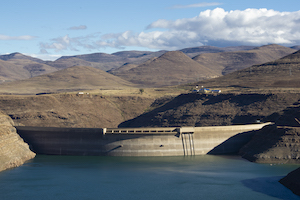You are here: Explore > Places to Visit > Katse Dam
One of the most ambitious engineering projects ever undertaken in South Africa, Katse is the continent’s second-largest double-curvature arch dam. Some 710-metres long and 185-metres high, it impounds a deep, squiggly, multi-tendrilled reservoir that extends back more than 30km along the Malibamat'so River when full and has a total surface area of 38.5 square kilometres.
 Reputedly named after a wealthy local farmer, Katse was constructed in the early 1990s as the centrepiece of the Lesotho Highlands Water Project (LHWP). Water from Katse is funnelled through an 82km underground tunnel into the Ash River near Clarens, South Africa, from where it flows along a succession of natural waterways into the Vaal Dam, the main reservoir in the industrialised and densely populated South African province of Gauteng.
Reputedly named after a wealthy local farmer, Katse was constructed in the early 1990s as the centrepiece of the Lesotho Highlands Water Project (LHWP). Water from Katse is funnelled through an 82km underground tunnel into the Ash River near Clarens, South Africa, from where it flows along a succession of natural waterways into the Vaal Dam, the main reservoir in the industrialised and densely populated South African province of Gauteng.
Visitors coming on the A25 from Maseru will pass the tunnel’s intake tower to their left as they cross the reservoir on Mphorosane Bridge near Ha Lejone, some 30km before reaching the dam itself. Also visible from the bridge is a cluster of circular fish farms that produces the trout for which Lesotho is famed.
Informative guided tours of the dam wall and boat trips onto the reservoir can be arranged at the helpful LHWP Visitors' Centre, which stands right above the dam and has an interior designed to mimic it.
.jpg) A highlight of a visit to the dam is the Katse Botanical Garden, which was established in 1995 as a sanctuary for Afro-Alpine flora rescued from land soon to be submerged by the reservoir. Reputed to be the highest botanical garden in the southern hemisphere, the garden stands at an altitude of 2,230 metres adjacent to Katse village and it extends across 17 hectares of terraced slopes crisscrossed with well-maintained footpaths.
A highlight of a visit to the dam is the Katse Botanical Garden, which was established in 1995 as a sanctuary for Afro-Alpine flora rescued from land soon to be submerged by the reservoir. Reputed to be the highest botanical garden in the southern hemisphere, the garden stands at an altitude of 2,230 metres adjacent to Katse village and it extends across 17 hectares of terraced slopes crisscrossed with well-maintained footpaths.
The garden protects more than 500 indigenous plant species, including various proteas, aloes, lilies and red-hot pokers, all adapted to with stand harsh winters that often bring heavy snowfall. The more interesting species are clearly labelled. Particularly prominent is the spectacular orange-flowered spiral aloe, which is the national flower of Lesotho, and totally unmistakable thanks to the neat spiral rosette formed by its whorl of fleshy grey-green leaves. Look out too for the pink-blooming Lesotho lily, the bizarre pineapple flower, and the snake aloe with its unique sinuous footlong inflorescence.
The garden has a lovely location and it is also a magnet for decorous birds such as the Cape and southern masked weavers whose neat oval nests adorn naturally-occurring stands of ouhout trees, and the brilliant iridescent malachite sunbirds that flit between flowers in search of fresh nectar.
Sleeping: Katse Lodge offers comfortable and affordable catered accommodation in Katse village, a few kilometres from the dam. The lodge stands next to Katse Botanical Gardens and it offers great views over an oxbow-shaped part of the reservoir hemmed in by steep hills.
Eating: A good a la carte restaurant is attached to Katse Lodge.
Access: Katse Dam lies about 225km from Maseru. To get there follow the A1 northeast as far as Leribe, then turn southeast onto the A25 to Katse. Allow up to four hours for the direct drive, longer if you decide to stop at Bokong Nature Reserve, which flanks the A25 between Leribe and Katse. Regular public transport runs between Maseru and Katse via Leribe.



